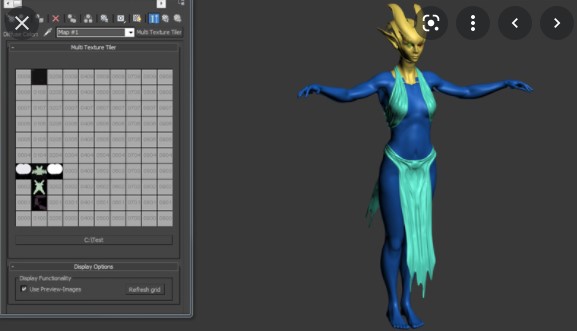I make use of these other quadrants for simple materials like fabric or huge skin areas. But when mapping is crucial for any object, they are placed into the main quadrant, where I can render a UV map. Maps for my bump and spec also reside included in composite maps. They are set to render each quadrant as it is a diffuse map. Get More Softwares From Getintopc
Password 123
Multi Texture Map
I thought that if my unwrap uvw material at 2, it will be corresponding to the texture that is in the second slot on the sub material. I’ve applied the Unwrap Uvw to my editable poly, and have made sure all my seams are exactly how I want them.
Multi Texture Map Features
It is advantageous because textures are read in a linear manner. They generally include RGB color data, and occasionally an additional channel for alpha blends specifically to be used for decals, billboards, or overlays. It is also possible to utilize the alpha channel to perform other applications, such as specularity.
For flight simulators, textures mapping provides crucial motion signals. Screen subdivision since it is less overhead. Screen subdivision is also utilized to extract high-detail images from 3D modeling software or point cloud scan and to approximate the models using meshes that are more appropriate for rendering in real-time. The way in which samples (e.g. when seen in the form of pixels) are calculated using pixels is controlled by texture filtering. The most affordable option is to utilize the interpolation of nearest neighbors, however, bilinear interpolation and trilinear interpolation of mipmaps are frequently used options that can minimize jaggies or aliasing. If the texture coordinates are outside the texture, it’s either wrapped or clamped.

There are a variety of blend methods that are available… A channel-packed trim sheet is used to give a complete texture check out the Polycount Forum. Witcher 3.0 Blood and Wine architectural material makes use of vertex color to blend textures into an array. Multi-Texture refers to the mixing of different types of textures onto the same material. This technique isn’t used in modern hardware as UV coordinates are more adaptable for modeling and are more reliable for clipping.
However, the distortion of perspective can be seen in primitives close to close to the camera (e.g. for instance, the Saturn Port in Sega Rally exhibited texture-squashing artifacts since nearby polygons were the camera but were not clipped with any UV coordinates). Affine texture mapping is a linear interpolation of texture coordinates over the surface and is the most efficient form that maps texture. Certain software and hardware programs project vertex coordinates within 3D spatial space on the display during rendering, and linearly interpolate the coordinates of the texture within the screen space (“inverse text mapping”). This can be accomplished by increasing the fixed point UV coordinates and/or by the incremental error method similar to the Bresenham line algorithm.
Additionally, I frequently use multi/sub-objects in my work (I do not have a problem with this technique as I am aware of how they function! ) But, not for characters that are detailed, I would rather use that same diffuse slots. Also, I was referring to memory when it comes to rendering, not the performance of viewports. If the same material is used for a different component, it’s so that more details can be provided to that section.
How to Get Multi Texture Map for Free
I’ve tried using multiple unwrap uvw modifiers with different IDs of materials, which correspond to the materials of the sub-material but it’s not working as it should. Could you please clarify what’s the purpose of the material ID for this unwrap UVW modifier? It is where you can use multiple unwrap UVW with different material IDs within one object. 3. Making a multi-sub material that contains my various texture maps and putting on a couple of different standard textures to test (i.e. one blue, one red). The thing I’d like to create is several textures for different aspects of a person (without needing to manually select the selection of polygons and assign different material IDs to the sub-multi).
Texture mapping initially referred to diffuse mapping a technique that simply mapped pixels of an image to the 3D area (“wrapping” images around objects). Multi texturing refers to the application of multiple textures at the same time on the polygon. For example, lightmap textures could be used to illuminate a surface, as an alternative to calculating the lighting each moment the object is rendered.
The texture mapping map converts the model’s surface onto texture space. in this space, the texture map is viewable in its natural shape. UV unwrapping tools generally allow a view into texture space to allow manual editing of the texture coordinates.
Anisotropic filtering can eliminate distortions in the direction of view when looking at textures from oblique angles. Multiple textures can be combined into array textures or texture atlases to minimize state changes on modern hardware. Modern hardware usually allows cube map textures that have multiple faces to facilitate environment mapping. If performance is a problem, look at smaller textures or alter your viewport to show the lower quality of your textures, i.e. Personally, I don’t understand why you’d assign the same texture to different MatID’s? Even if you check your Asset Tracking, it only links the file one time regardless of how many times it’s referenced in your scene.
A channel-packed trim sheet, which is used for Mass Effect 3, see Mass Effect 3 art – Marc-Antoine Hamelin on the Polycount Forum. The Build engine has extended the constant distance trick that was used in Doom by concluding the constant distance line for polygons of any size and rendering it.
Multi Texture Map System Requirements
- Operating System: Windows XP/Vista/7/8/8.1/10.
- Memory (RAM): 1 GB of RAM required.
- Hard Disk Space: 5 GB of free space required.
- Processor: Intel Dual Core processor or later.
